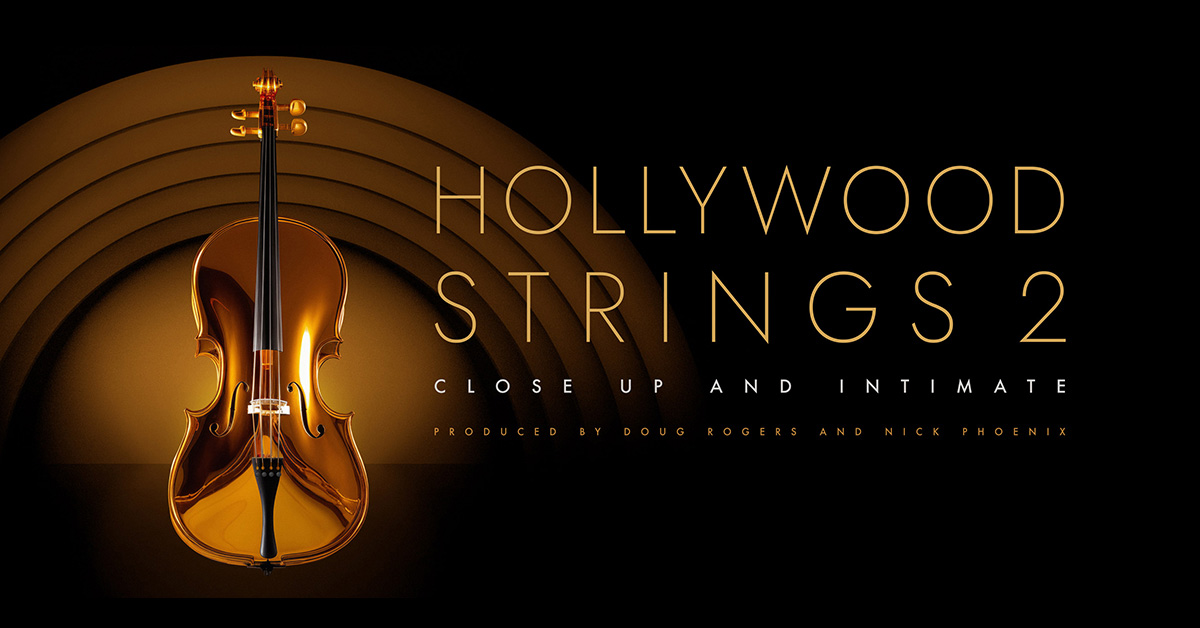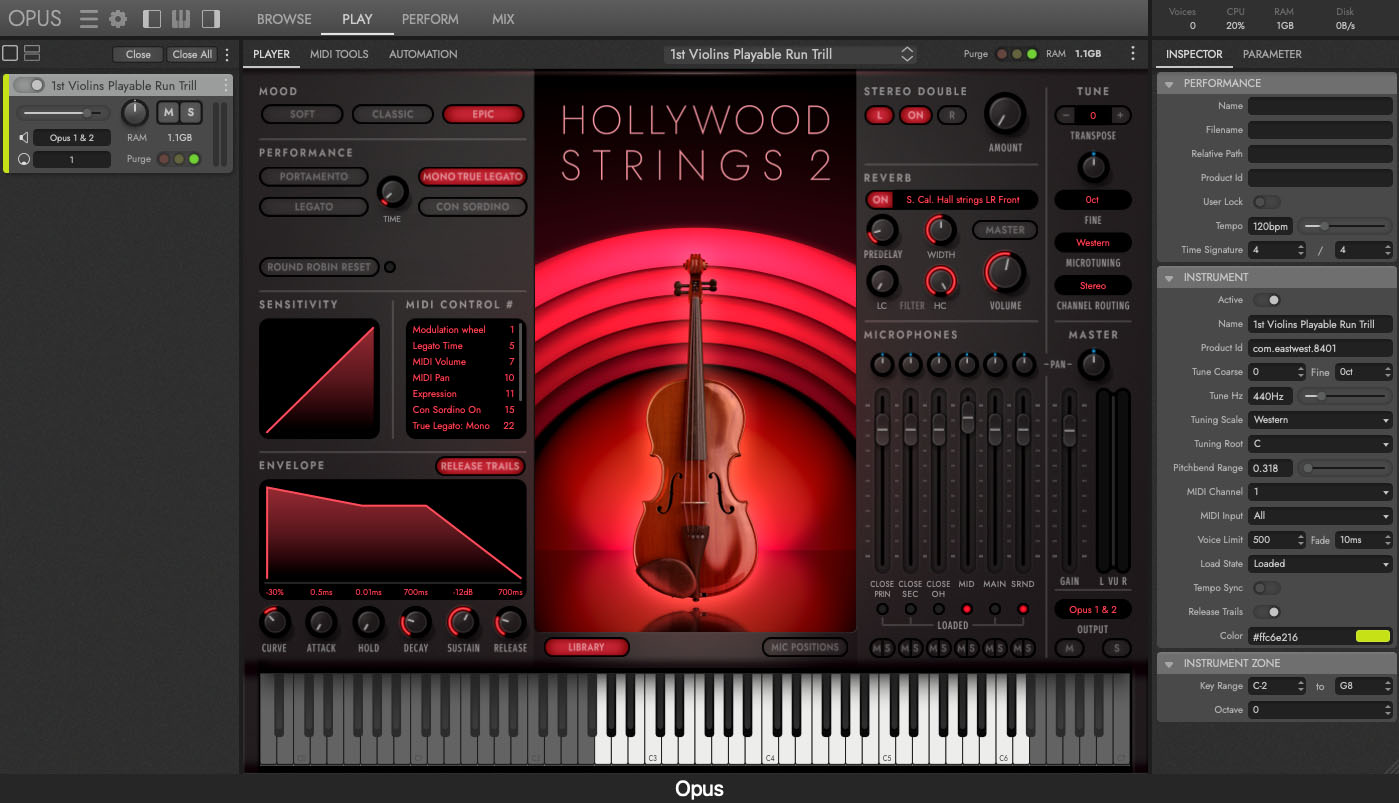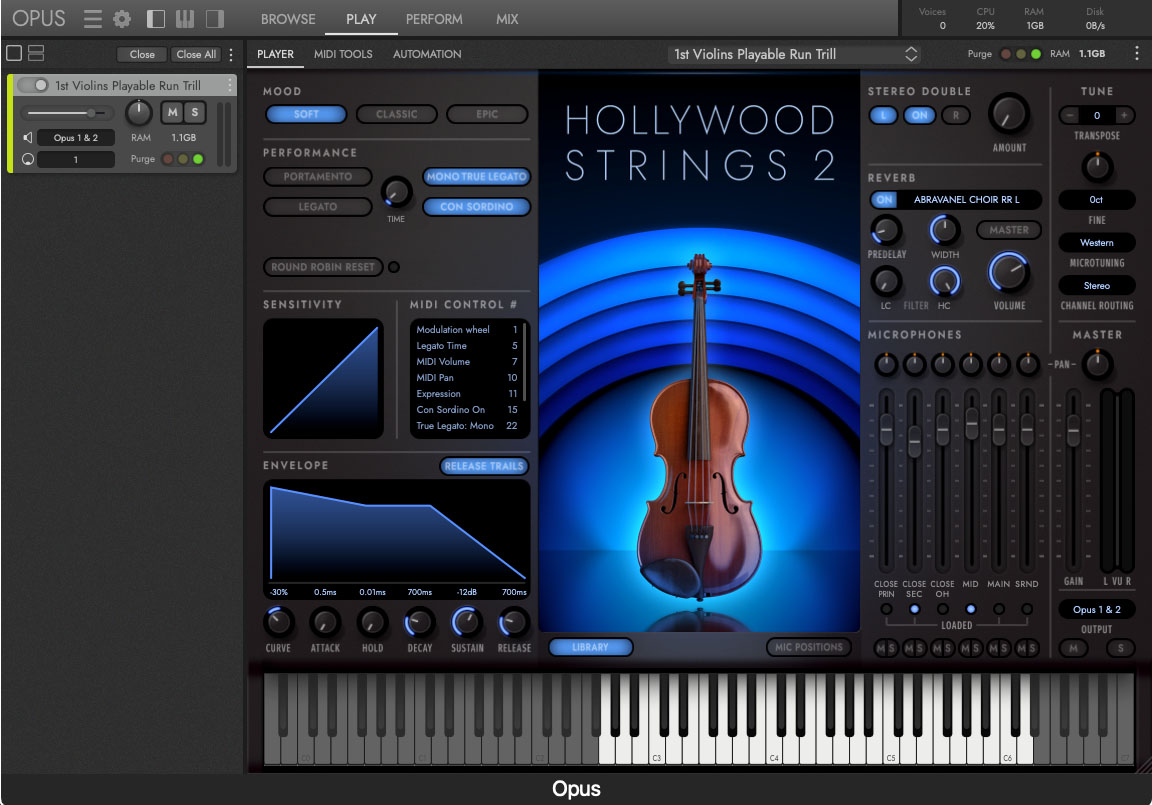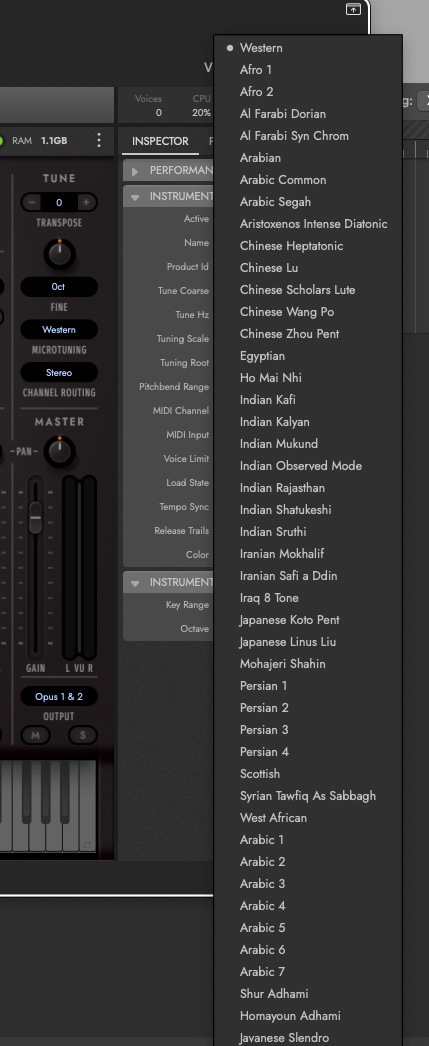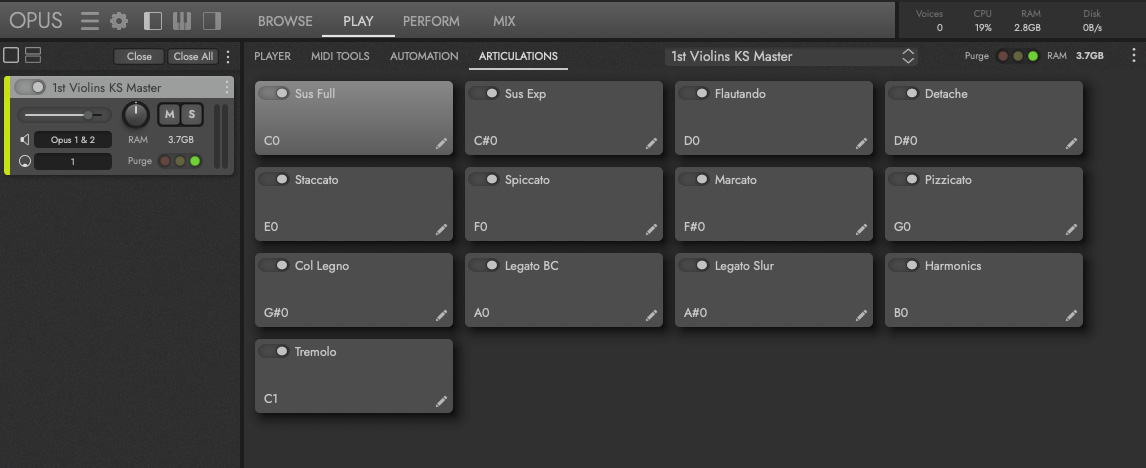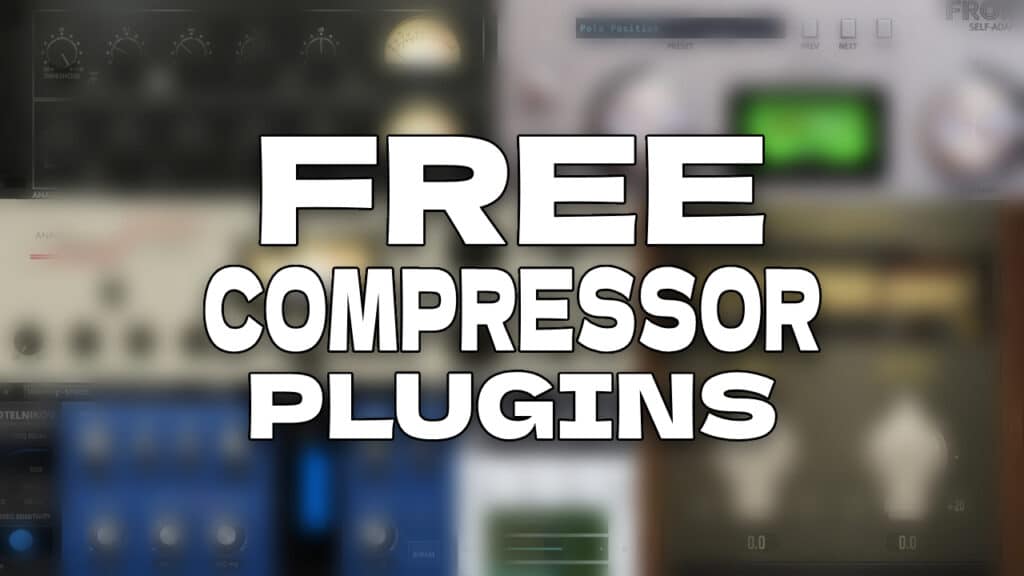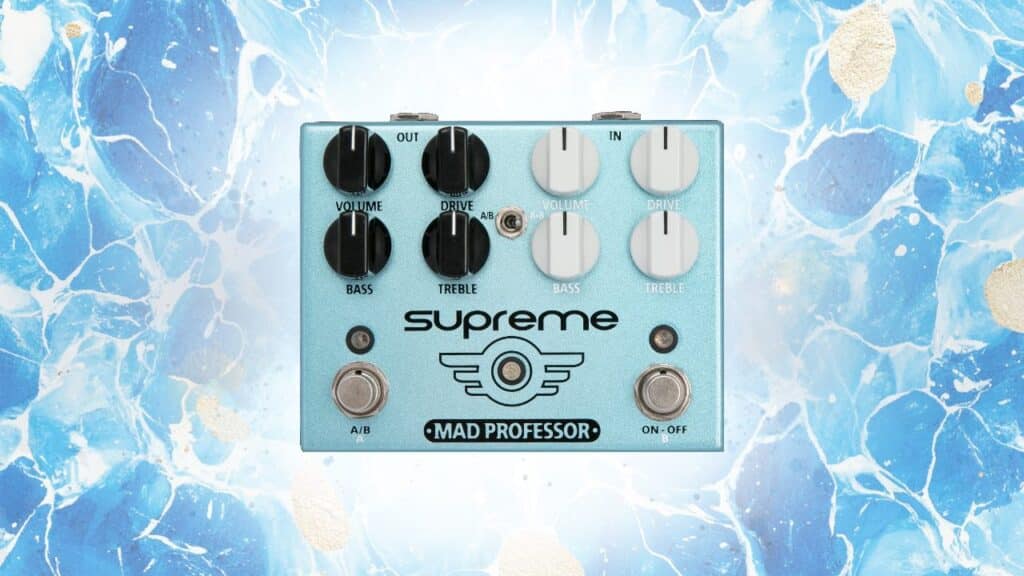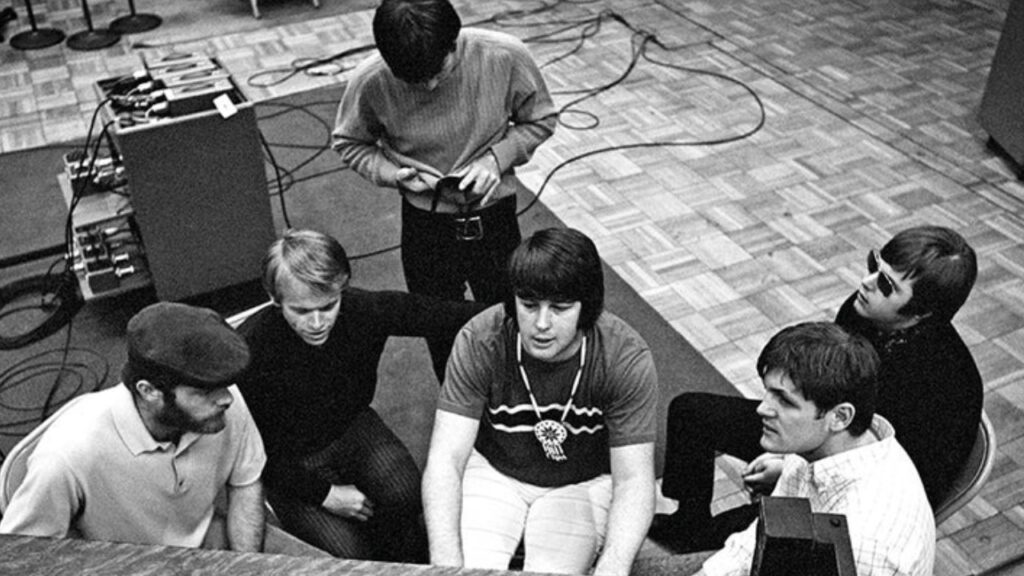Hollywood Strings 2 has arrived and from first impressions, it was well worth the wait! This 21-piece orchestra was recorded in EastWest Studio 2 by Doug Rogers, Nick Phoenix, and Shawn Murphy.
HOLLYWOOD STRINGS 2 AND THE OPUS INTERFACE
Opus is the EastWest environment for accessing their sample libraries that replaces the Play plugin. It is fully compatible with NKS and can be used in NI Komplete Kontrol and Maschine, hardware and software. EastWest Sounds can be browsed and previewed. Instrument parameters are pre-mapped to NI hardware and software.
STRING SECTIONS
The library features:
- 1st Violins x 6
- 2nd Violins x 4
- Violas x 4
- Celli x 4
- Basses x 3
- Full Strings
BROWSE WINDOW
This is where you find the sound you’re after based on a searchable menu that categories libraries by Instrument/Type/Style/Timbre. An example would be:
Strings/Full Strings/Orchestral/Aggressive
This setting would yield a resulting instrument called Full STR Detache RR.
You can save favorite instruments by clicking the star icon which will save you time later when you’re looking for a particular sound used previously.
On the right side of the GUI, you can choose to show the Inspector/Parameter window which displays details about the main product and the instrument currently selected including the same derivation in the help screen mentioned above as well as changeable range settings, file path, and your own personal rating and comments. These sorts of details are important for composers who need to find instruments they like to use in particular contexts quickly.
PLAY WINDOW
In this window, you’ll find instrument-specific parameters such as portamento, legato, sordino, velocity sensitivity, ADSR, Mic positions, stereo doubling, channel routing, etc. A few controls that stand out include Mood which has three settings–soft, classic, and epic. These settings seem to use a combination of mic position, reverb, and muting to change the color and spatial depth of the sound.
Soft – an intimate sound with rolled-off high-end
Classic – brighter with more space
Epic – full-blown reverb and depth for a huge modern Hollywood string sound
The Reverb menu is expansive and boasts a huge collection of convolution reverbs including chambers, plates, springs, gated verbs, etc.
The Microtuning menu is a welcomed feature for composers who want to experiment with or explore new harmonic colors. This is one benefit sample libraries have over real instruments. Try retuning a chamber orchestra to anything other than 12 EDO and let the chaos ensue.
ARTICULATIONS
The library includes a robust array of traditional articulations and playing techniques including well-conceived round robins where warranted by a particular technique–Spiccato settings use up to 10 RRs.
In Opus, clicking on a particular instrument triggers the display of a help screen that describes how the samples were produced, how you might use the sound in context, and how to sound is programmed to react to playing and CC messages like the Mod wheel and Expression (CC 11). Quick access to these helpful hints is incredibly useful for composers not completely familiar with string terminology or more experienced composers who want to quickly determine the capabilities and playability of the instrument at hand.
When an instrument with multiple articulations is loaded (those named with KS for key switching for instance), an Articulation window is visible where you can assign key switches to change articulations on the fly. I know a lot of composers prefer to use separate instruments and tracks for each articulation, but sometimes the context and ease of use make key-switching a nice option to have, especially with user-friendly programming like this is available.
Another nice feature is Monophonic True Legato described by EastWest here:
MONOPHONIC TRUE LEGATO is enabled by default on instruments that use “true” portamento and legato samples, where each portamento and legato interval is meticulously sampled for ultimate realism. It forces monophonic playback (by default), and uses MIDI Note Velocity to adjust the timing of the legato transition playback, resulting in a looser or tighter feel depending on hard hard or soft you play.
Playing softly (around a Note Velocity range of 50-60) will result in a longer legato transition time, allowing the melody to breathe more. Playing more forcefully (around a Note Velocity range of 110-127), will result in a shorter legato transition time, tightening up the timing between notes. When Note Velocity is used to control Legato Speed, it does not affect loudness.
Below is a list of included articulations by instrument:
1ST VIOLINS
Long
- Detaché
- Sustain Non-Vibrato
- Sustain Vibrato
- Sustain Expressive
Shorts
- Col Legno
- Legato Repetitions
- Marcato
- Pizzicato
- Spiccato
- Staccato
- Staccato Slur
- Staccato Runs Up
- Staccato Runs Down
Effects
- Flautando
- Harmonics
- Tremolo
Legato
- Legato Bow Change
- Legato Portamento
- Legato Slur
- Legato Slur Expressive
- Legato Playable Run Trill
2ND VIOLINS
Long
- Detaché
- Sustain Non-Vibrato
- Sustain Vibrato
- Sustain Expressive
Shorts
- Bartok Pizzicato
- Col Legno
- Legato Repetitions
- Marcato
- Pizzicato
- Spiccato
- Staccato
- Staccato Slur
- Staccato Runs Up
- Staccato Runs Down
Effects
- Flautando
- Tremolo
Legato
- Legato Bow Change
- Legato Portamento
- Legato Slur
- Legato Slur Expressive
- Legato Playable Run Trill
VIOLAS
Long
- Detaché
- Sustain Non-Vibrato
- Sustain Vibrato
- Sustain Expressive
Shorts
- Bartok Pizzicato
- Col Legno
- Legato Repetitions
- Marcato
- Pizzicato
- Spiccato
- Staccato
- Staccato Slur
- Staccato Runs Up
- Staccato Runs Down
Effects
- Flautando
- Harmonics
- Tremolo
Legato
- Legato Bow Change
- Legato Portamento
- Legato Slur
- Legato Slur Expressive
- Legato Playable Run Trill
CELLI
Long
- Detaché
- Sustain Non-Vibrato
- Sustain Vibrato
- Sustain Expressive
Shorts
- Bartok Pizzicato
- Col Legno
- Legato Repetitions
- Marcato
- Pizzicato
- Spiccato
- Staccato
- Staccato Slur
- Staccato Runs Up
- Staccato Runs Down
Effects
- Flautando
- Harmonics
- Tremolo
Legato
- Legato Bow Change
- Legato Portamento
- Legato Slur
- Legato Slur Expressive
- Legato Playable Run Trill
BASSES
Long
- Detaché
- Sustain Non-Vibrato
- Sustain Vibrato
Shorts
- Bartok Pizzicato
- Col Legno
- Marcato
- Pizzicato
- Spiccato
- Staccato
Effects
- Harmonics
- Tremolo
Legato
- Legato Bow Change
- Legato Slur
- Legato Slur Expressive
FULL STRINGS
Long
- Detaché
- Sustain Non-Vibrato
- Sustain Vibrato
- Sustain Expressive
Shorts
- Bartok Pizzicato
- Col Legno
- Marcato
- Pizzicato
- Spiccato
- Staccato
Effects
- Flautando
- Harmonics
- Tremolo
Live 21 Piece Ensemble
- Sustain Non-Vibrato
- Sustain Vibrato
AVAILABILITY AND COMPATIBILITY
Hollywood Strings 2 is available with a perpetual license (currently $399) or by subscribing to the EastWest Composer Cloud which boasts a ridiculous 42,000 instruments for $19.99/month or $149/year. Student pricing is also available. See subscription pricing here.
The Opus environment is compatible with all major DAWs on Mac and Windows. System recommendations include:
MINIMUM SYSTEM
- CPU: Quad-core (four cores), running at 2.7 GHz (or above)
- RAM: 16 GB
- OS: macOS 10.15 (or later); Windows 10 with ASIO sound drivers
- Drive: HDD (7200 rpm, non-energy saving)
RECOMMENDED SYSTEM
- CPU: Octa-core (eight cores), running at 2.7 GHz (or above)
- RAM: 32 GB or more
- OS: macOS 10.15 (or later); Windows 10 with ASIO sound drivers
- Drive: SSD (SATA or PCIe)
It ran flawlessly on my MacBook M1 (OS 13.6.1) (16 GB of RAM) in Logic Pro (10.8.1) with samples loaded on an external SSD drive. Of course, I wasn’t pushing it too hard. I can see where the extra RAM and CPU speed would come in handy with large sessions.
VIDEOS
Product Walkthrough
Official Trailer
CONCLUSIONS
Hollywood Strings 2 lives up to the hype with everything from intimate chamber sounds to epic soaring string textures. If you’re looking for sound-design stylized strings and a ton of extended techniques, look elsewhere. That is not what Hollywood Strings 2 is about. But this is a great library for realistic string sounds, including pristine samples of A-list players recorded by some of the industry’s best engineers and all the tools you need to compose with traditional articulations. As with all acoustic instrument sample libraries, the magic happens in the programming of automation controls for expression, dynamics, vibrato, etc. This library is no exception and requires that composers exercise due diligence and automate the necessary parameters to make this library really sing. That said, you can still create amazing percussive textures using the pizzicato and other short articulations right out of the box. A solid foundational string library from EastWest Sounds.
EXTRAS
Participate in the 3rd Waveinformer contest: Sound Design, Foley, Dialogue, and Score for an Imaginary Scene: Fiendish Whispers – for a chance to win prizes from Monkeyc and iZotope. Details here!
Want to win a free version of Kontakt 7? Be one of the first 1000 followers to our Instagram Page for a chance to win a full version of Kontakt 7 from Native Instruments. More details here.
Assess your knowledge of essential audio concepts using our growing catalog of online Quizzes.
Explore more content available to Subscribers, Academic, and Pro Members on the Member Resources page.
Not a Member yet? Check the Member Benefits page for details. There are FREE, paid, and educational options.

